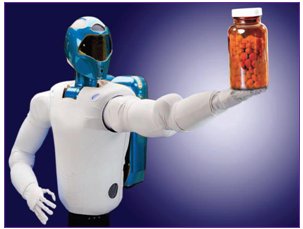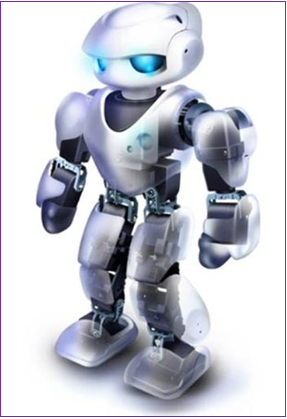 About Authors:
About Authors:
Roopesh Sachan1*, Prof. Satyanand Tyagi2, Tarun Parashar1, Soniya1, Patel Chirag J3, Patel Pinkesh3, Devesh Kaushik4
1*Department of Pharmaceutics, Himalayan Institute of Pharmacy and Research, Rajawala, Dehradun, Uttarakhand, India-248007.
2President & Founder, Tyagi Pharmacy Association (TPA) & Scientific Writer (Pharmacy), Chattarpur, New Delhi, India-110074.
3Department of Pharmaceutics, Maharishi Arvind Institute of Pharmacy, Mansarovar, Jaipur, Rajasthan, India-302020.
4Territory Business Manager, Diabetes Division, Abbott Healthcare Private Limited, Okhla, New Delhi, India- 110020.
*roopeshsachan@gmail.com, +91-9557469989, 9236167104
ABSTRACT:
In the world of pharmaceuticals, there is a vital role for robotics to play in the complicated processes of research and development, production, and packaging. Justification for robots ranges from improved worker safety to improved quality. Speeding up the drug discovery process is another benefit of robotics. Drug Production Robotics plays an important role in the manufacture of pharmaceutical drugs because, unlike other industries, pharmaceuticals demand higher speed and accuracy. Devices such as syringes, inhalers, IV bags and diabetes testing kits are made with the help of robotics. There is a great potential for the use of robotics systems in the pharmaceutical industry and pharmaceutical companies are gradually injecting more robotic systems into their operations.
[adsense:336x280:8701650588]
Reference Id: PHARMATUTOR-ART-1577
INTRODUCTION
The International Organization for Standardization gives a definition of robot in ISO 8373: "An automatically controlled, reprogrammable, multipurpose, manipulator programmable in three or more axes, which may be either fixed in place or mobile for use in industrial automation applications."
Reprogrammable: whose programmed motions or auxiliary functions may be changed without physical alterations;
Multipurpose: capable of being adapted to a different application with physical alterations;
Physical alterations: alteration of the mechanical structure or control system except for changes of programming cassettes, ROMs, etc.
Axis: direction used to specify the robot motion in a linear or rotary mode [1, 2]. The Robotics Institute of America defines a robot as Re-programmable multi-functional manipulator designed to move materials, parts, tools, or specialized devices through variable programmed motions for the performance of a variety of tasks.
THREE LAWS OF ROBOTICS
1. A robot must obey orders given to it by human beings except where such orderswould conflict with the First Law.
2. A robot must protect its own existence as long as such protection does not conflictwith the First or Second Law.
3. A robot may not injure a human being or, through inaction, allow a human being tocome to harm [3].
[adsense:468x15:2204050025]
ADVANTAGES OF PHARMACEUTICALROBOTS
1. Accuracy: Robotic systems are more accurate and consistent than their human counterparts.
2. Tirelessness: A robot can perform a 96 man-hour project in 10 hours with more consistency and higher quality results.
3. Reliability: Robots can work 24 hours a day, seven days a week without stopping or tiring.
4. Return on investment (ROI): There is quick turn-around with ROI. Plus, with the increase in quality and application speed, there are the benefits of increased production possibilities.
5. Affordability: With the advancements in technology and affordable robotics becoming available at less cost, more pick and place robotic cells are being installed for automation applications.
6. Production: With robots, throughput speeds increase, which directly impacts production. Because robots have the ability to work at a constant speed without pausing for breaks, sleep, vacations, they have the potential to produce more than a human worker.
7. Quality: Robots have the capacity to dramatically improve product quality. Applications are performed with precision and high repeatability every time. This level of consistency can be hard to achieve any other way.
8. Speed: Robots work efficiently, without wasting movement or time. Without breaks or hesitation, robots are able to alter productivity by increasing throughput.
9. Flexibility: Packaging applications can vary. Robots are easily reprogrammed. Changes in their End of Arm Tooling (EOAT) developments and vision technology have expanded the application-specific abilities of packaging robots.
10. Safety: Robots increase workplace safety. Workers are moved to supervisory roles, so they no longer have to perform dangerous applications in hazardous settings.
11. Savings: Greater worker safety leads to financial savings. There are fewer healthcare and insurance concerns for employers. Robots also offer untiring performance which saves valuable time. Their movements are always exact, so less material is wasted.
12. Redeployment: The flexibility of robots is usually measured by their ability to handle multiple product changes over time, but they can also handle changes in product life cycles.
13. Reduced chances of contamination: Removing people from the screening process reduces the potential for contamination and the potential for dropped samples when handling them in laboratories. Robotics performs these tasks much faster with more precision and accuracy.
14. Cost: Paybacks for the purchase of robotic equipment in the pharmaceutical industry, given the fairly high hourly labor rates paid to employees, number of production shifts, and the low cost of capital. A typical robot installation, complete with accessories, safety barriers, conveyors, and labor, could cost around $200,000. If that robot were to replace four manual workers each earning approximately $30,000 per year, the robot would be paid for through salary savings alone in a little more than a year and a half.
15. Work continuously in any environment: Another advantage in the laboratory is that robots are impervious to many environments that would not be safe for humans. A robot can operate twenty-four hours a day, seven days a week without a dip in accuracy [4-6].
DISADVANTAGES OF PHARMACEUTICAL ROBOTS
1. Expense: The initial investment of robots is significant, especially when business owners are limiting their purchases to new robotic equipment. The cost of automation should be calculated in light of a business' greater financial budget. Regular maintenance needs can have a financial toll as well.
2. Dangers and fears:
Although current robots are not believed to have developed to the stage where they pose any threat or danger to society, fears and concerns about robots have been repeatedly expressed in a wide range of books and films. The principal theme is the robots' intelligence and ability to act could exceed that of humans, that they could develop a conscience and a motivation to take over or destroy the human race.
3. Expertise: Employees will require training in programming and interacting with the new robotic equipment. This normally takes time and financial output.
4. Return on investment (ROI): Incorporating industrial robots does not guarantee results. Without planning, companies can have difficulty achieving their goals.
5. Safety: Robots may protect workers from some hazards, but in the meantime, their very presence can create other safety problems. These new dangers must be taken into consideration [7].
NANO-ROBOTS
Nano-robots are so tiny machines that they can traverse the human body very easily. When a nano-robot enters into the body of a patient would seek for infected cells and would repair them without causing any damage to the healthy cells. The nano-robot will remain outside the cell while the nano-manipulators will penetrate into targeted or damaged cell thus avoiding any possibility of causing damage to the intracellular skeleton. Thus these nano-robots when enter into human bloodstream provide cell surgery and extreme life prolongation. Each nano-robot by itself will have limited capabilities, but the coordinated effort of a multitude will produce the desired system level results. Coordination is needed across the board for communication, sensing, and acting and poses a major research challenge [8].
NOW YOU CAN ALSO PUBLISH YOUR ARTICLE ONLINE.
SUBMIT YOUR ARTICLE/PROJECT AT articles@pharmatutor.org
Subscribe to Pharmatutor Alerts by Email
FIND OUT MORE ARTICLES AT OUR DATABASE
ROBOTS USED IN PHARMACEUTICAL INDUSTRY
1. Pharmaceutical Container Replacement Robot:
This autonomous robot is capable of navigating tight spaces at factories for the purpose of transporting containers used in the pharmaceutical manufacturing process.
The robot can automatically connect itself to large containers (or cases packed with products) weighing up to 200 kilograms (440 lbs) for transport. The robot only needs to be charged once per day, it can be freely programmed and customized to suit the manufacturing process, and it is safe and easy to use on existing production lines. Three robots are now working on production lines at a pharmaceutical factory, where they have reportedly boosted productivity by 30% [9].
2. Cylindrical Robot for High Throughput Screening:
ST Robotics presents a new 4-axis cylindrical robot for DNA screening in applications such as forensic science, drug development, bacterial resistance, and toxicology. The R19 is a totally new design that may be supplied as a precise 4-axis robot, or as a simple 2-axis plate mover. It is usually mounted on a track, which can be up to five meters long, surrounded by various laboratory instruments. The robot moves samples from instrument to instrument according to a protocol decided by the user. Advanced drives create swift and smooth motion while maintaining quiet operation in the lab environment.
Like all Sands Technology robots, the new R19 is a totally reliable workhorse, tested to ISO 9000 quality assurance. The KUKA KR 1000 Titan is the company's latest product and with its heavy weight capabilities has earned an entry in the Guinness Book of Records. The KR 1000 Titan is the world's first industrial robot that can lift a payload of 1000 kilograms with a reach of 4000 mm and will be handling a Chrysler Jeep body. The Titan is ideally suited to handle heavy, large or bulky work pieces. The heavyweight champion was developed for sectors such as the building materials, automotive and foundry industries.
This robotic food and pharmaceutical handling system features a visual tracking system and a pair of multi-axis robot arms that each can accurately pick up 120 items per minute as they move along a conveyor belt. The arms can work non-stop 24 hours a day, are resistant to acid and alkaline cleaners, and feature wrists with plastic parts that eliminate the need for grease. The sanitary design provides the cleanliness required of machines tasked with handling food and medicine. With a proven record of success in reducing manufacturing costs and improving quality, about 150 systems have been sold to manufacturers worldwide since October 2006 [9, 10].
3. Six-Axis Robots suit Class 1 Clean Room Applications:
Running on Smart Controller (TM) CX controls and software platform, Adept Viper (TM) s650 and Adept Viper (TM) s850 bring precision motion and 6-axis dexterity to clean room assembly, handling, testing, and packaging applications. With integrated vision and embedded networking, robots target customers in solar, disk drive, LCD, semiconductor, and life sciences markets [9].
4. Space Saving Ceiling Mounted Robot:
Adept Technology has introduced a ceiling-mounted version of its s800 series Cobra robot. The inverted robot offers high-speed packaging and assembly with a wider reach, while leaving a much clearer working area. The new robot offers several advantages over its predecessor, which is floor-mounted and traditionally sits beside the conveyor belt or packing line. While the Cobra s800 Inverted Robot has a reach of 800mm, the same as the previous floor-mounted model, being mounted on the ceiling above the conveyor effectively doubles this reach. The machinery can also be supplied with a vision system of up to four cameras, which identify the position of products on the conveyor belt and link back to the robot so it can accurately pick up and orientate the product for assembly or packaging [9, 11].
5. Metal Detector Targets Pharmaceutical Industry:
Incorporating Quadra Coila system, Goring Kerr DSP Rx screens pills and capsules at out feed of tablet presses and capsule filling machines. It offers adjustable in feed heights from 760-960 mm and angular adjustments of 20-40°. System features open-frame design and polished, stainless steel finish. For maximum hygiene, pneumatics and cables are contained within unit stand. Mounting bars have round profiles to remove risk of debris and bacteria traps [9, 12, 13].

Figure 1: Robot with medicine

Figure 2: Industrial Robot
APPLICATIONS OF ROBOTS PHARMACEUTICAL INDUSTRY [13-16]
There is a vital role for robotics to play in the complicated processes of research and development, production, and packaging. Justification for robots ranges from improved worker safety to improved quality. Speeding up the drug discovery process is another benefit of robotics. A number of robot manufacturers have products specifically designed for this industry.
1. Research and Development (R&D)
Robots now also play an essential role in the development of new drugs. In high throughput screening (H.T.S.) for instance, millions of compounds are tested to determine which could become new drugs. There is a need for the use of robotics to test these millions of compounds. The use of robotics can speed this process up significantly, just as they can any other process where a robot replaces a person completing any repetitive task.
2. Control Systems
Most robots have onboard controllers that communicate with other machines' programmable logic controllers (PLCs) or with personal computers (PCs) networked to the line. Robot controller is an industrial VME bus controller that connects to PCs for networking and for graphical user interfaces.
3. Laboratory Robotics
This new technology allows human talents to be concentrated on sample selection and submittal, and scrutiny of the resulting data, rather than monotous tasks that lead to boredom and mistakes. The desired results of this automation are of course better data and reduced costs. Using laboratory robotics, new experimental procedures are eliminating human tedium and miscalculation in washing and transferring. This includes experiments in radioactive, fluorescent, and luminescent analysis Laboratory robotics is being increasingly applied in pharmaceutical development to help meet the needs of increasing productivity, decreasing drug development time and reducing costs. Three of the most common geometries for laboratory robots are: Cartesian (three mutually perpendicular axes); cylindrical (parallel action arm pivoted about a central point); and anthropomorphic (multijointed, human-like configuration).
4. Sterilization and Clean Rooms
Robotics can be adapted to work in aseptic environments. Clean room robots have features that protect the sterile environment from potential contamination. These features include low flake coatings on the robotic arm, stainless steel fasteners, special seal materials, and enclosed cables. Clean room robots reduce costs by automating the inspection, picking and placing, or loading and unloading of process tools. Benefits of robot use in the clean room include:
1. Robots minimize scrap caused by contamination.
2. Robots reduce the use of clean room consumables such as bunny suits.
3. Robots reduce scrap by minimizing mishandled or dropped parts.
4. Training costs and clean room protocol enforcement are minimized.
5. Robots reduce the amount of costly clean room space by eliminating aisles and access ways typically required for human clean room workers. Robots can also be enclosed in mini environments. This permits relaxed cleanliness throughout the remainder of the plant.
5. Packaging Operations:
Packaging processes, like other pharmaceutical operations, benefit from the speed and repeatability that automation brings. Robotics in particular provides flexibility and accuracy. In some packaging applications such as carton loading, robotics also performs more efficiently than dedicated machines. Pharmaceutical packaging machines are often custom designed to handle specific product configurations such as vials.
Advantages over Traditional Automatic Packaging Machines
In contrast to packaging machines that automatically stop if too much product accumulates at the discharge, robotic loaders and unloaders meet or exceed the in feed and discharge rates that packaging machines require. This ability allows the robot to keep the packaging process running at full production capacity.
Advantages of Robotic Automation of Packaging
1. Speed - Robots work efficiently, without wasting movement or time. Without breaks or hesitation, robots are able to alter productivity by increasing throughput.
2. Flexibility - Packaging applications can vary. Robots are easily reprogrammed. Changes in their end of arm tooling (EOAT) developments and vision technology have expanded the application-specific abilities of packaging robots.
6. Flexible Feeding
Robots are also better than hard automation at flexible feeding, a task that involves handling multiple types of products or packages whose orientation always varies. Traditionally, packaging lines have used high-speed, automated bowl feeders that vibrate parts and feed them to fillers, labelers, or product-transfer mechanisms. Bowl feeders, however, can't always handle a variety of products at once, and their vibration can damage fragile parts.
7. Vision Systems
A vision system provides a valuable tool for determining the accuracy of text and graphics in pharmaceutical and medical packaging. The chief benefit offered by adding a robot to the vision system is speed. It inspect insert in less than two minutes. The same inspection performed by one operator and checked by a second operator could take from 30 minutes to an hour.
8. Grinding Applications
Manual grinding is tough, dirty, and noisy work. The metal dust produced by grinding is harmful to a worker's eyes and lungs. Grinding robots save manufacturing employees from having to endure hazardous work environments.
9. Sterile Syringe Filling
Stericlean, the result of three-way collaboration between robotics specialist Staubli, factory automation firm ATS and pharmaceutical manufacturer Sanofi-Aventis, was introduced at Interphex with the claim that it is the only robot arm on the market that can be used in barrier isolation systems. Stericlean has replaced manual processes and given us a significant increase in productivity.
10. Biopharma and Diagnostic Applications
It provides standardized solutions that offer high throughput and ensure reproducible, accurate results in areas such as genomics, cells and proton sciences and forensics. It covers an extensive portfolio of biopharma applications, supplying pharmaceutical laboratories with automated solutions for cell culture, nucleic acid extraction, normalization, genotyping, protein purification and analysis, hit-picking, ADME screening, PCR applications and protein crystallography.
DISCUSSION AND CONCLUSION
Incorporating robots into pharmaceutical processes has many advantages. Robots can perform operations three or four times faster than humans and can function 24 hours per day. These characteristics make robots good at producing large quantities of products efficiently. By performing simple, repetitive tasks, robots can free employees for creative work such as developing new products.
The pharmaceutical industry, in turn, is favorable to robotic systems because its processes generally require low forces, take place in clean environments, and include predictable sets of operations.Pharmaceutical industries are intently seeking ways to reduce their expenses, increase their efficiency, and make high-quality products. Robots can help companies achieve these ends by providing speed, precision, repeatability, and flexibility. Because they can improve discovery, pilot production, and small-scale production, robots can be a particularly powerful foundation for the growing biotechnology industry.
ACKNOWLEDGEMENT
The corresponding author, Roopesh Sachan is highly thankful to his Parents and Teachers for their moral support and encouragement. Last but not the least, support of all my friends and the one above all of us, the omnipresent God, for answering my prayers for giving me the strength to plod on despite my constitution wanting to give up and throw in the towel, thank you so much Dear Lord.
REFERENCES
1. ifr.org/industrial-robots/
2. ugress.com/post.asp?id=286
3. c2.com/cgi/wiki?ThreeLawsOfRobotics
4. robots.com/articles/viewing/benefits-of-robots
5. library.thinkquest.org/06aug/02423/new_page_7.htm
6. koolgrapsite.com/advantages-of-robotics.html
7. robots.com/blog/viewing/advantages-and-disadvantages-of-automating-with-industrial-robots
8. nanotechnology2008.blogspot.in/2008/01/nano-roberts.html
9. ceogujarat.nic.in
10. fanucrobotics.com/
11. expo21xx.com/search/SearchP.php?search_type=product&search_string=robots
12. Lachman, L., Lieberman, H.A. and Kanig, J.L., In; The Theory and Practice of Pharmacy, 3rd edition, Varghese Publishing House, Bombay, 1991,660.
13. robotics.org/content-detail.cfm/content_id/2867
14. kuka-robotics.com/en/solutions/branches/chemical/start.htm
15. msuweb.montclair.edu/~olsenk/robot.htm
16. pinktentacle.com/
NOW YOU CAN ALSO PUBLISH YOUR ARTICLE ONLINE.
SUBMIT YOUR ARTICLE/PROJECT AT articles@pharmatutor.org
Subscribe to Pharmatutor Alerts by Email
FIND OUT MORE ARTICLES AT OUR DATABASE









